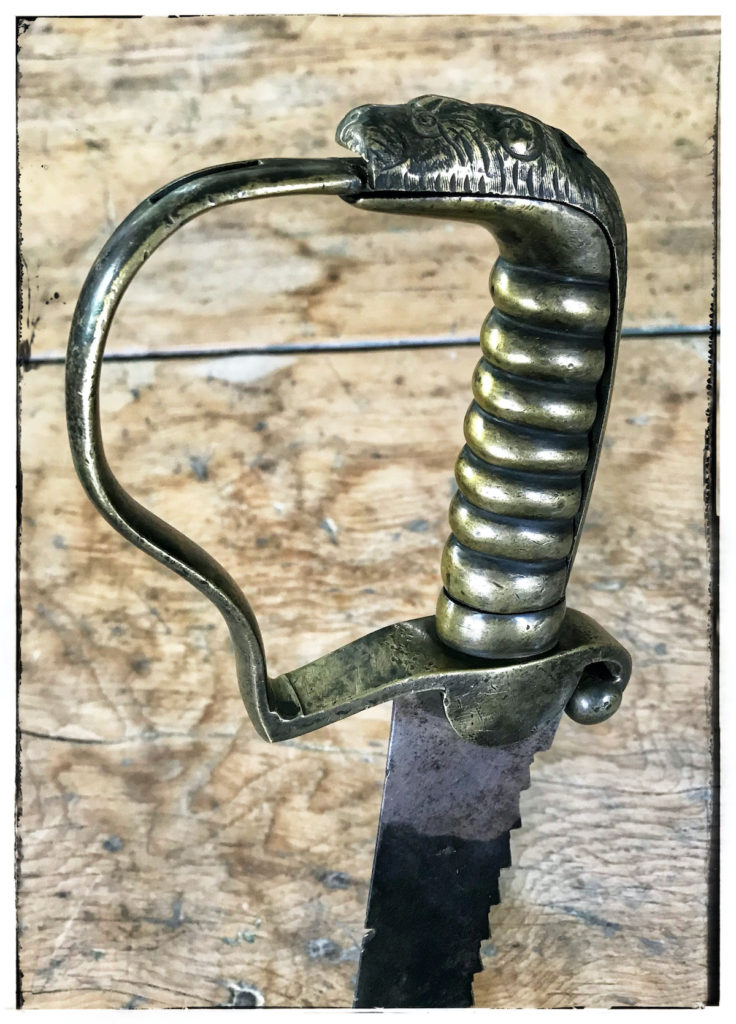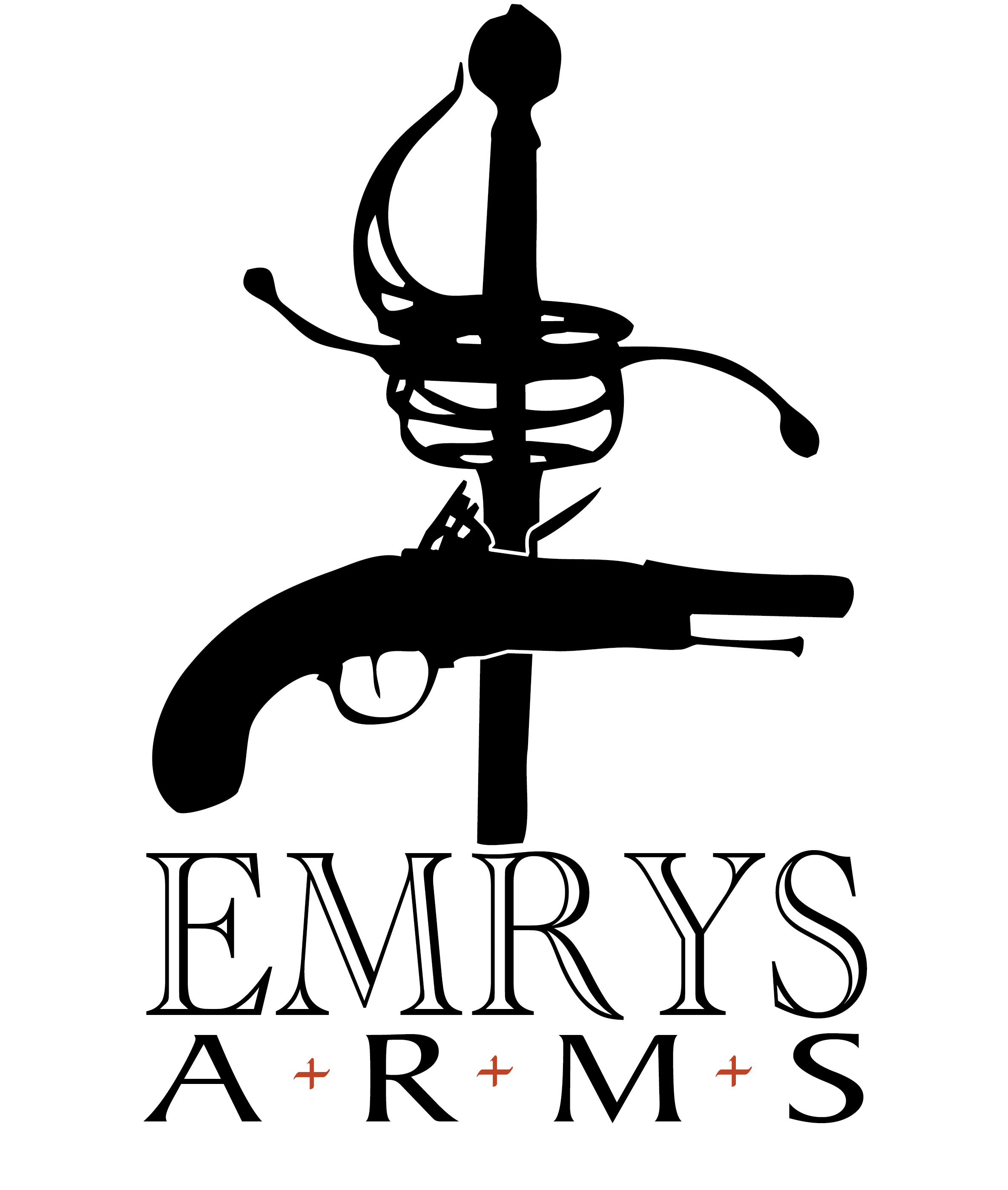| Collection #: | 2020.026 |
|---|---|
| Type: | Pioneer OR Baker Rifleman's sword |
| Nationality: | British |
| Pattern: | No official pattern |
| Date: | c.1816 - 1830 |
| Hilt: | Brass |
| Blade Length: | 55.9cm (22") |
| Blade Width: | 4.3cm (1.69") |
| Overall Length: | 67.4cm (26.54") |
| Maker: | Osborn & Gunby (1808 - 1820) |

This sword (or hanger as it is a short sword) has a brass grip with lion’s head pommel. There is a bit of movement in the brass grip caused by mild deformation to the guard, but is otherwise solid. The blade starts at a width of 4.3cm, narrows down to 3.3cm for the length of the blade with the saw back then widens back out to 4.1cm. The saw back of the blade is very rugged and in perfect condition. The slightly curved blade on the other hand suffers from obvious abuse for three-quarters of its length before terminating in a spear point. This sword came out of Fredericton, New Brunswick and was part of the lot purchased with 2020.024, which also shows significant blade damage. The spine of the blade at the forte, just under the bent quillon is marked to Osborn & Gunby, thus its production date lies somewhere between 1808 and 1820. The blade itself bears a government view mark of a crown over 1. These are all the markings on this piece. Considering how much abuse it appears this sword has taken, it has stood up quite well.
Much like swords 2020.024, 2020.025 and 2020.027, this (unofficial) pattern of sword suffers from an identity crisis. By that I mean, it never seems to have received an official pattern status. This has caused some to call it a pioneers sword (sort of the precursor to engineers), an artillery sword (based on references in military reports), and the last theory I have read is that it was a Baker rifleman’s sword.
Harvey Withers in his book British Military Swords: 1786-1912 The Regulation Patterns lists this as a c.1830 Pioneer private’s sawback sword. He acknowledges that this sword never seemed to receive a pattern designation, but seems to have been the only British Army sawback pioneer sword before the introduction of the official 1856 pattern pioneer sword. (Page 74)
Brian Robson also lists this as a pioneer sword in his book, Swords of the British Army. However, he also mentions a report from the Select Committee on Artillery which lists a small evolution of swords carried by artillerymen. One of the swords supposedly carried between 1843 and 1845 was a sawbacked sword that was tried for a short time. This is the only saw-backed sword known to exist in any quantity, so this may be the sword discussed. (Pages 231-232)
The third theory is presented by De Witt Bailey in his book British Military Flintlock Rifles 1740-1840. He lists this sword as a pattern 1816 saw-back rifleman’s sword in his book. The supporting evidence for this is a record of the preference by the Adjutant General in June of 1815 for the “sword…proposed to be adopted for the service of Rifle Corps, would be rendered still more eligible, by being made applicable to the purposes of a Saw…”(page 143) In March of 1816, a contract to various suppliers would fulfill an initial order of 5000 of these swords. Of that order, 640 were listed as being made by Osborn & Gunby, who made this example.
Bailey notes that speculation still exists as to the exact identity of the rifleman’s sawback sword. However, there is a strong feeling that this is indeed the sword being discussed. That theory is backed up by Howard L. Blackmore, who was among many things, the Deputy Master of the Royal Armouries, H.M.Tower of London. (Page 144)
It is, I suppose, entirely probable that this style of sword could have been used among various branches of the army, depending on where its benefits could be employed. It is a short robust sword, though some complained that it was overly heavy at 2.6lbs. Its sawback blade was useful for “cutting down light timber and brushwood, in the case of artillery to make gun platforms and gabions and to clear a line of sight”.(Robson, pg. 232) And so this sword fulfilled multiple roles and seems to have thus found a home in many places.
To read the full accounts of what these authors have recorded, check out the following books:
Bailey, D.W. (2002) British military flintlock rifles 1740-1840. Andrew Mowbray Publishers, Lincoln, Rhode Island, U.S.A.
Withers, H. (2010) British military swords: 1786-1912 the regulation patterns. Harvey Withers Military Publishing, Sutton Coldfield, UK.
For further visual research, feel free to look up the following books for photos of other examples of this sword.
Bailey – British Military Flintlock Rifles 1740-1840. Page 143.
Dufty – European Swords and Daggers in the Tower of London. Plate 78.
Robson – Swords of the British Army: The Regulation Patterns 1788-1914. Page 233. For a similar, possibly officers version, page 260 may be based on the Infantry Flank Officer’s pattern 1803.
Southwick – The Price Guide to Antique Edged Weapons. Page 119.
Withers – British Military Swords: 1786-1912 The Regulation Patterns. Pages 74 & 81.
Wilkinson Latham – British Military Swords: From 1800 to the Present Day. Page 36.

